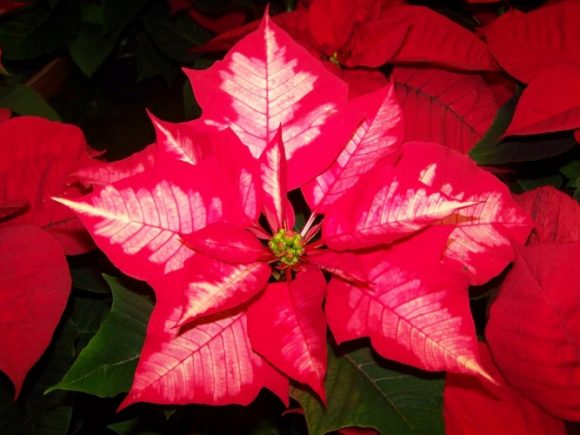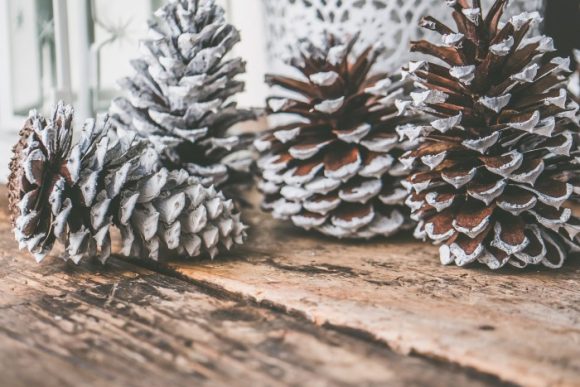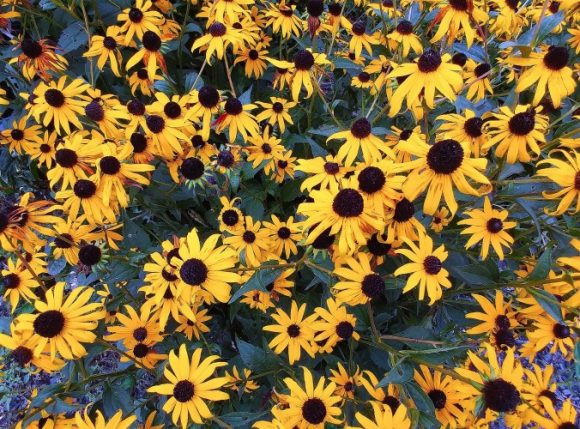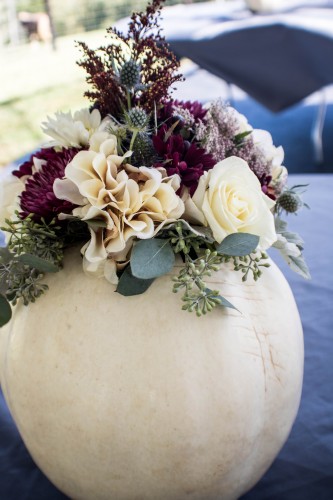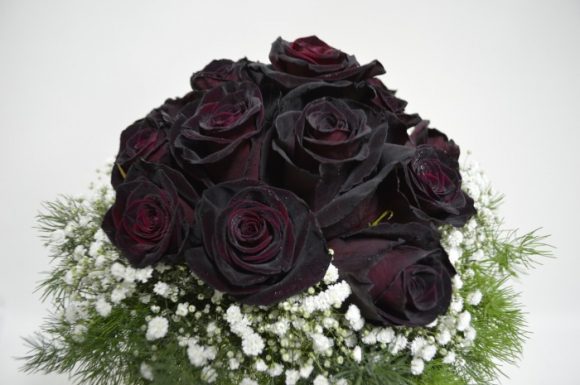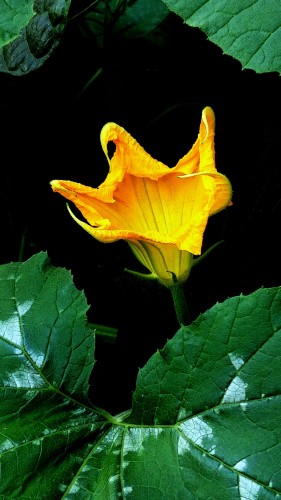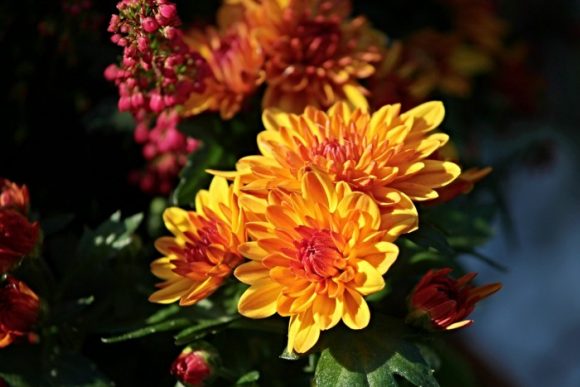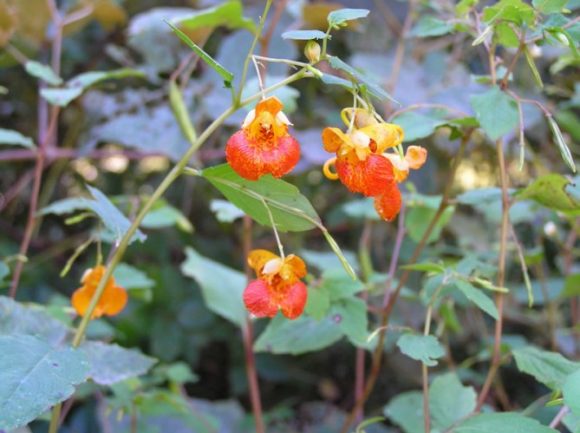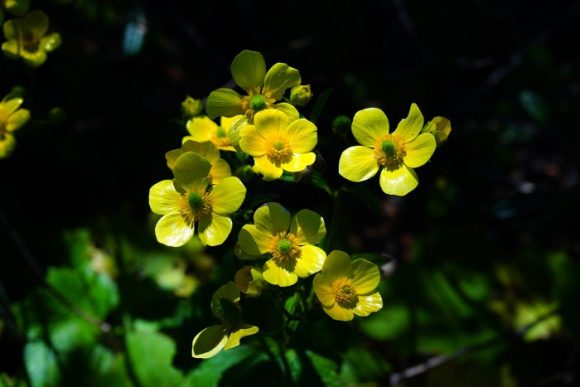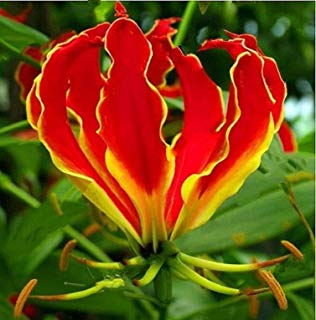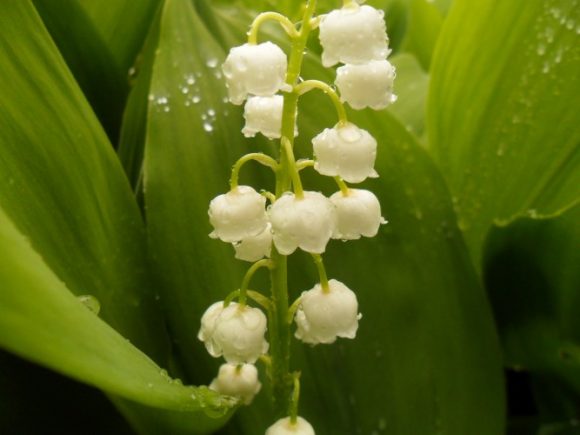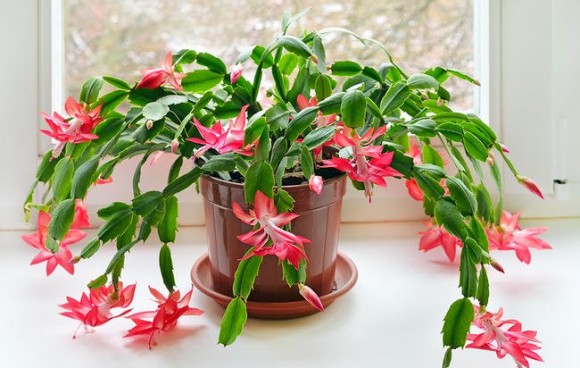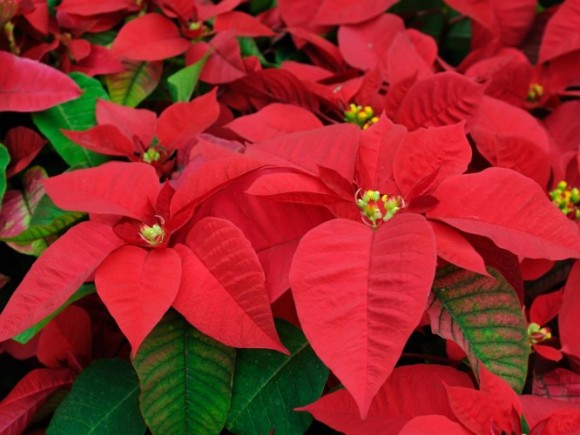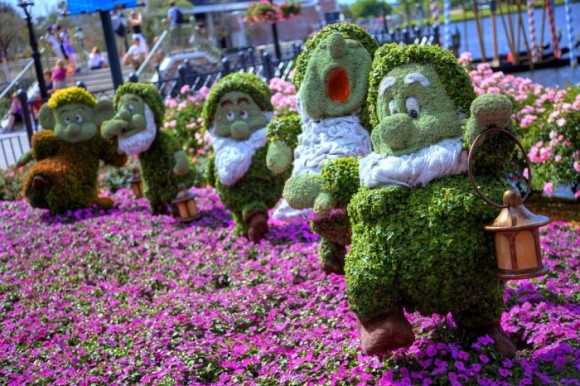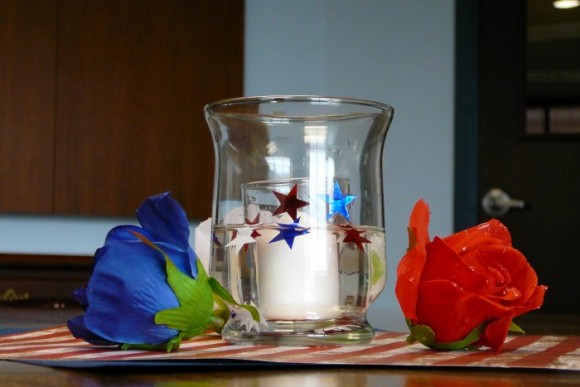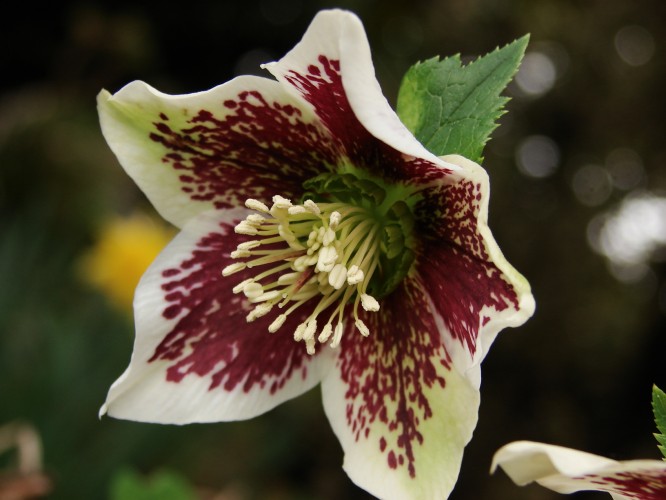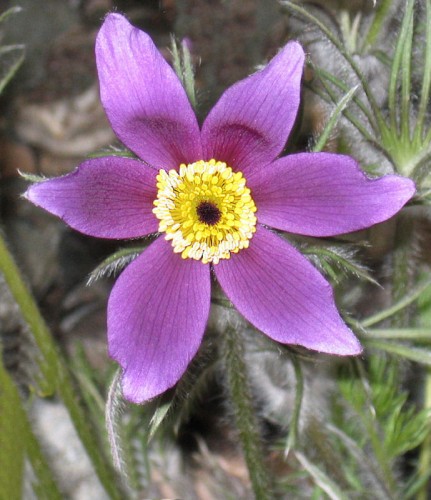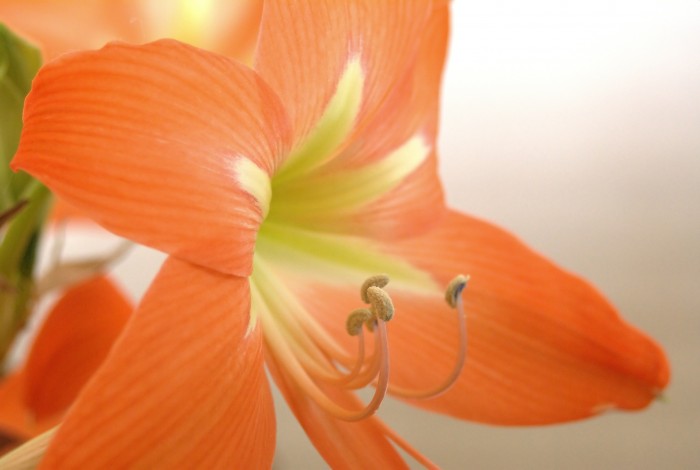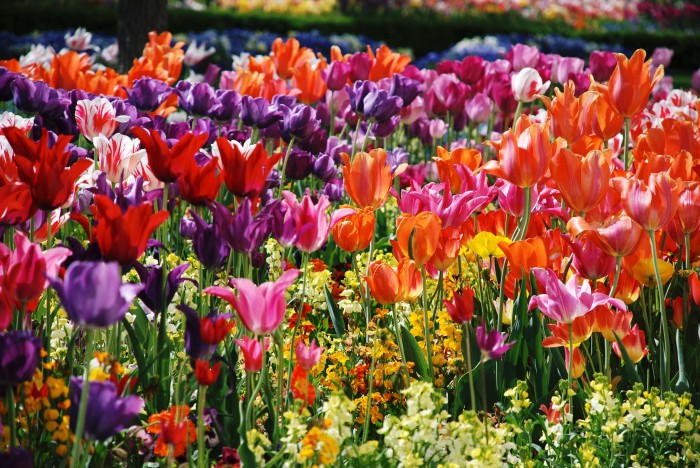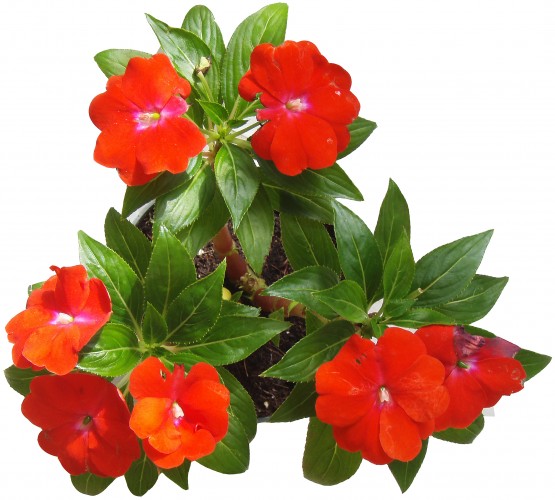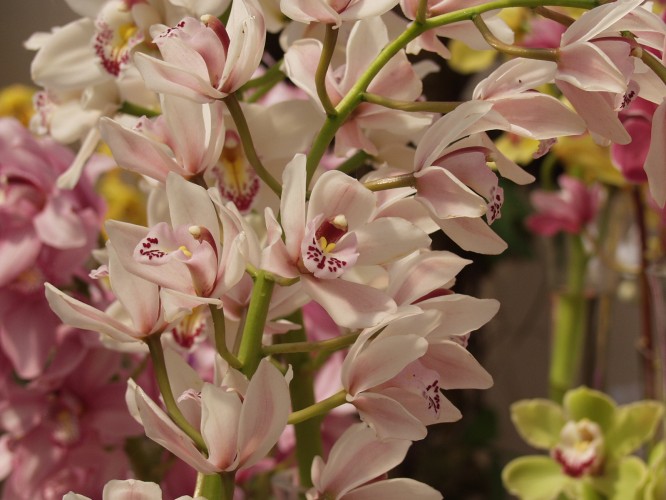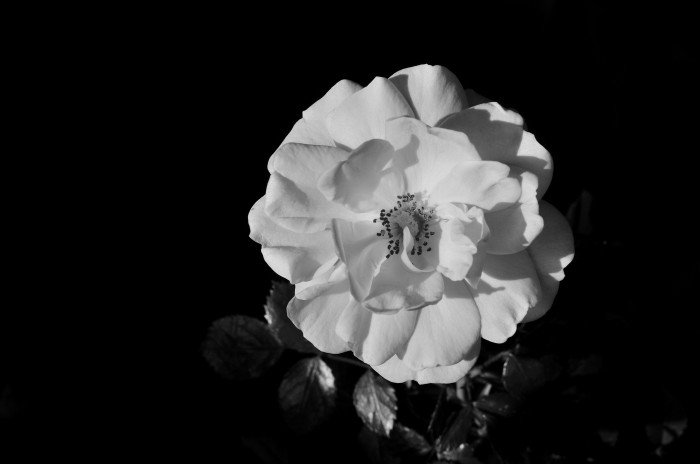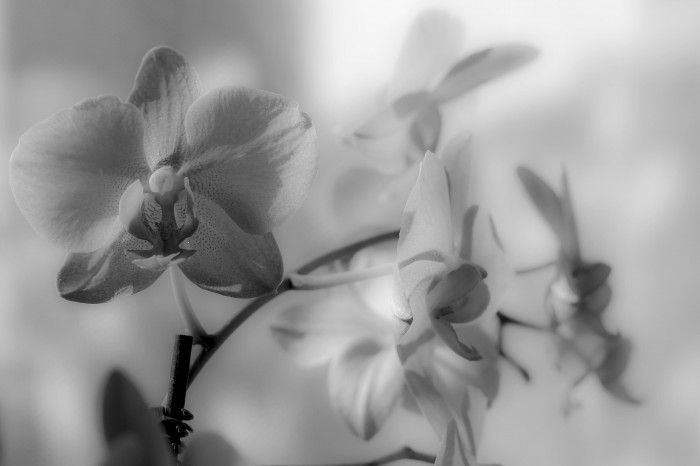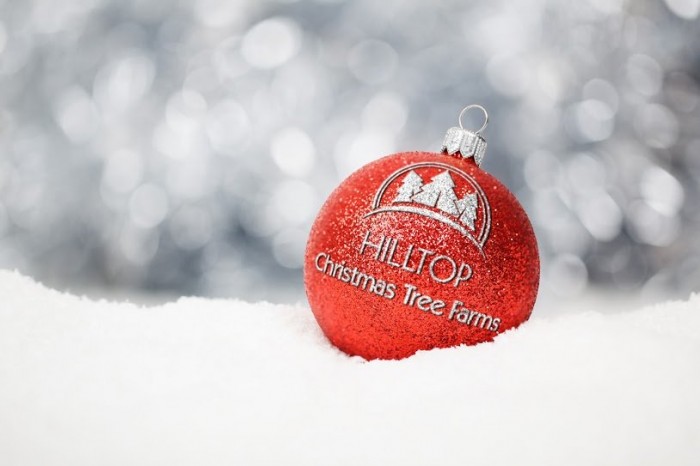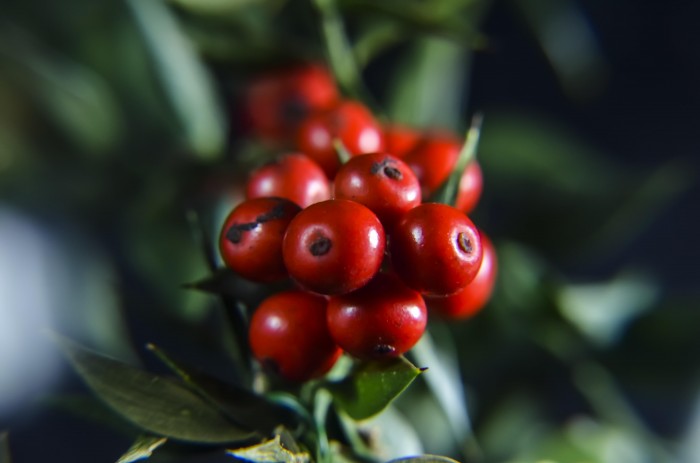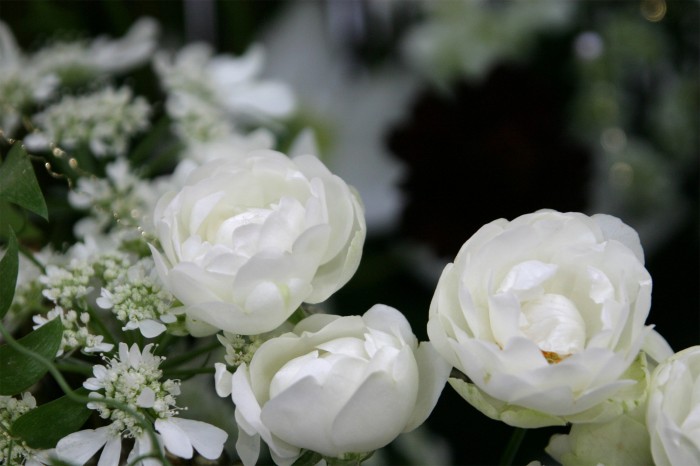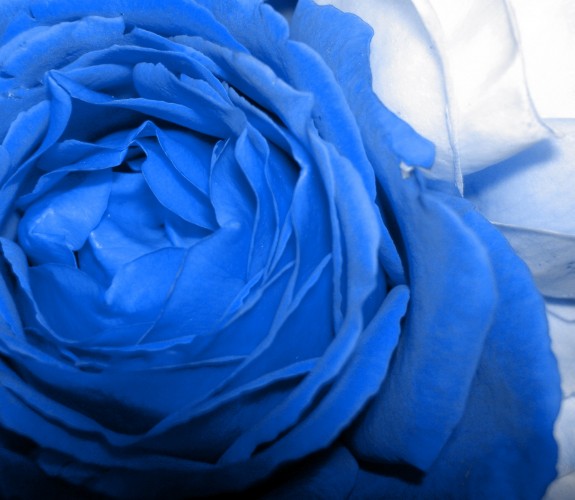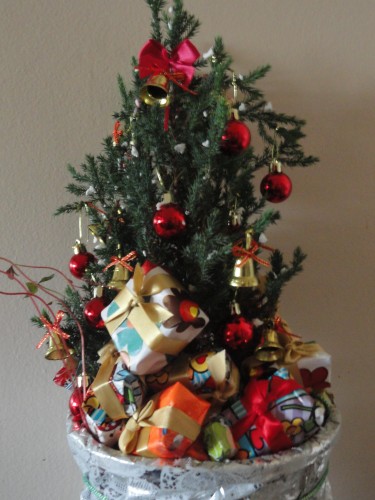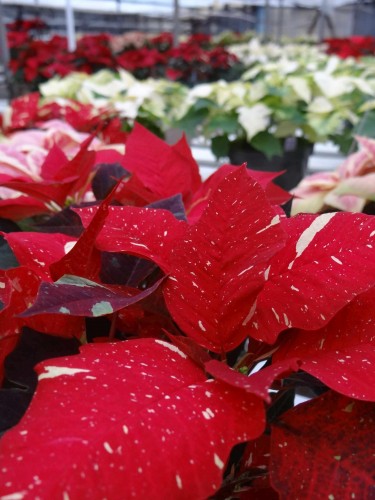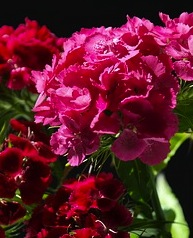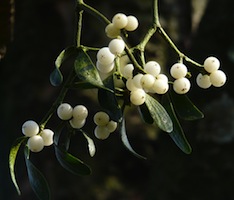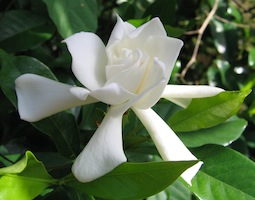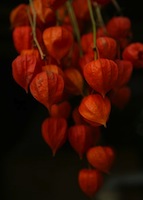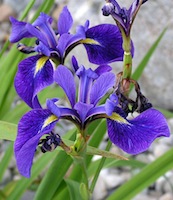Search Results for “”
Falling in Love with Autumn Blooms: Nature’s Vibrant Palette!
Autumn is a season that enchants us with its magical colors and crisp air. As the leaves turn into vibrant shades of red, orange, and yellow, nature surprises us with its beautiful blooms. From delicate dahlias to charming chrysanthemums, autumn flowers paint the world with their vibrant hues. Here are two of our favorites, which look beautiful indoors and out! Continue reading [...]
Festive Flowers for a Dazzling Winter Bouquet or Centerpiece
Winter is full of holidays and family gatherings that fill us with happiness and gratitude. Whatever you celebrate, a wintery bouquet will be a cheerful addition to any decor. Continue reading [...]
Forcing Flower Bulbs For the Holiday Season
Forcing flower bulbs is a method of cooling and gradually re-warming bulbs so that they will bloom indoors, outside of their normal season. In the cool days of winter, these flowers make a wonderful, low-maintenance gift for anyone, including gardeners and floral enthusiasts. Continue reading [...]
Spruce Up Your Holiday Home with Poinsettias
The cheerful poinsettia is a classic Christmas decoration that is beloved around the world. The poinsettia has been associated with Christmas since the 1600s. The plants are indigenous to dry forests in Central America, where legends have long told of a young girl bringing the crimson blooms to a church as a gift for the baby Jesus. Continue reading [...]
Easy Embellishments for a Winter Wonderland Bouquet
Adding non-floral accents to a bouquet is a fun way to customize your flower arrangement. There are lots of festive options available at craft stores or online retailers. With cool weather right around the corner, here are some ways to turn any bouquet into one fit for a winter wonderland. Continue reading [...]
Saffron: The Treasure of the Fall-Blooming Crocus
The purple fall-blooming crocus is a celebrated member of the iris family. Not only does it have graceful, lavender-colored blooms, but this particular type of crocus has a treasure inside: saffron. Continue reading [...]
How to Incorporate Edible Flowers into your Holiday Meals
If you want to make your holiday dishes tasty and unique, add edible flowers. From sides and entrees to desserts, there are numerous ways to use these delicious blooms to enhance your cooking. Continue reading [...]
Celebrate Thanksgiving with Flowers Native to the US
For a fun and authentic approach to Thanksgiving decor, create floral arrangements that feature flowers native to the United States. Most of these plants should be available at a well-stocked florist, and many may even be in your own garden. Continue reading [...]
Create a Harvest Vase from a Pumpkin, Apple, or Gourd
A fun way to celebrate autumn is by crafting floral arrangements that use seasonal fruits as a natural vase. We can use the abundance of apples, pumpkins, and gourds to create festive containers for cheerful bouquets. Continue reading [...]
Celebrate the Harvest Season with a Floral Cornucopia
The cornucopia is a traditional symbol of a bountiful harvest. This beloved hallmark of the harvest season has long been associated with a plentiful yield. Filled with flowers and produce, the cornucopia proudly displays the best of the year's crops. Continue reading [...]
Spooky Blooms for Halloween
Many of us love to decorate for Halloween. In the United States, Halloween is second only to Christmas for money spent on holiday decor. If you want to incorporate flowers into your creepy adornments, there are lots of festive choices. Continue reading [...]
Create a Harvest Wreath from Your Garden
The autumn garden is full of vibrant colors that can be preserved by crafting a harvest wreath. Continue reading [...]
Edible Squash Blossoms to Share with Family and Friends
Do you have dozens of new squash blooms late in the growing season? It may be too late for those flowers to develop into fruits, but that doesn't mean they have to go to waste. Squash blossoms are edible and can be incorporated into a delicious harvest dinner.
Continue reading [...]
Stonecrop Brings “Autumn Joy” to the Garden
Stonecrop is a family of around 500 varieties of succulent plants that will add low-maintenance color and interest to your fall garden. Continue reading [...]
Japanese Anemones Shine in the Autumn Garden
As days grow shorter and summer blooms begin to fade, Japanese anemones come into their full glory. With oversized leaves and tall stems bearing charming flowers, Japanese anemones make a bold statement in your autumn garden. Continue reading [...]
Welcome Autumn with Chrysanthemums
Hardy chrysanthemums, also called mums, are a beacon of autumn in North America. Blooming in late summer through mid-fall, mums add a pop of color when other garden plants are dying back for the year. Continue reading [...]
“Exploding” Jewelweed is Popping with Fun
Jewelweed is a yellow or orange flowering plant whose claim to fame is that the ripe seed pods "explode" or burst open when touched. Much to the delight of children and fun-loving adults, these plants have a quite entertaining method of dispersing their seeds. Continue reading [...]
Buttercups are Sunshine in Flower Form
Buttercups are brilliant yellow members of the ranunculus family. Buttercups make up nearly one fifth of the species of this family. There are variations in the number of petals and where the flowers grow, but almost all varieties share the distinctive butter-yellow petals for which they are named. Continue reading [...]
Set Your Garden on Fire with Gloriosa Superba
With a scientific name like Gloriosa superba, you might say that this fiery beauty is superb in color and full of glory. And you would be right! Continue reading [...]
Bring on the Dancing Girls: Impatiens Bequaertii
Among the world’s rarest and most enchanting flowers, Impatiens bequaertii is part of the impatiens family but has no acknowledged species name. Most notable for their petals resembling little dancing ladies in skirts, they are commonly referred to as dancing girls. Continue reading [...]
The Flower Named after Meghan Markle, Duchess of Sussex: Clematis Meghan
Being in the royal spotlight comes with many challenges, but clearly has its sweet spots. Clematis Meghan, named after the Duchess of Sussex, is making its debut at the famed Chelsea Garden Show May 21-25, 2019. Continue reading [...]
Lily of the Valley is the Right Flower for Special May Occasions
Lilies of the valley are the traditional flower for the month of May. This tradition began in the 1560s when King Charles IX of France was given a stem of lily of the valley as a May Day gift. The flower has since been said to bring good luck. Continue reading [...]
The Right Perennial Blooms to Give for Mother’s Day
As Mother's Day approaches, many of us are looking for flowering gifts for loved ones. But many moms say they feel bad when the flowers fade after a few brief days of blooming. Consider giving them a perennial flowering plant instead of cut flowers. Continue reading [...]
Helleborus is an Early Messenger of Spring
Helleborus makes a thoughtful gift to a loved one's garden by providing color in winter and early spring. Usually found in shades of pinks and purples, their shape resembles a wild rose. Continue reading [...]
Daffodils Mean a Gift of Sunshine
Daffodils are considered by many to be an iconic symbol of spring thanks to their brilliant colors and fresh scent. Daffodils mean a gift of sunshine because of their cheerful colors in early spring. Continue reading [...]
Forsythia are Beacons of Springtime
Forsythia are beacons of springtime. When the branches and buds start to turn a brilliant shade of yellow, we know that warmer weather is right around the corner. Continue reading [...]
Tulips and Their Meanings as Gifts
Tulips are so beautiful that one bulb was once worth one hundred times the annual wage of many of Holland’s residents. At the height of Tulip Mania in the mid-1600s, these highly coveted bulbs were exchanged for large quantities of food and livestock. Continue reading [...]
Holiday Flowers to Give to Service Providers
If you need gift ideas for your building manager, valet, cleaning person, child’s teacher or any other service provider, flowers are perfect. They’re beautiful and festive, and they naturally come across as a genuine and caring present. Continue reading [...]
2017 Guide to Holiday Flowers
There’s still time to choose and send Holiday flowers this year. While it’s easy nowadays to find the perfect florist (online or otherwise) to make your holiday bouquets and deliver your seasonal sprigs, it’s not always simple to plan for flowers. What will your giftee like? Which flowers are in season? Will your message be perfectly conveyed with your choice? These questions find answers with consideration of the wide range of flowers available to give this season. Continue reading [...]
Tis the season! It’s time to give holiday flowers!
There are so many beautiful choices for gifting. What will it be? Blossoms in a classic or contemporary color? A floral arrangement featuring flowers in a traditional or totally modern shape? Continue reading [...]
It’s Almost Time for the Portland Rose Festival
The annual Portland Rose Festival takes place this year from May 26th to June 11th, in Portland, Oregon. The flower-filled event will give tourists and residents the chance to enjoy parades, marathons and, of course, roses like never before. Continue reading [...]
3 More Weeks of the 2017 Epcot International Flower & Garden Festival
Every spring at Epcot Walt Disney World Resort, the theme park blooms with color and inspiring shapes as the International Flower & Garden Festival takes over. This event typically runs from the beginning of March until the end of May, and it allows flower lovers and Disney guests to delight in a seasonal explosion of brilliant blooms and interactive exhibits. Continue reading [...]
Flowers for the 4th of July: Party Ideas for Food and Home Decoration
Throwing a 4th of July party this year and need ideas for pretty flowers that you can set out on a table? Looking for flowers that you ca incorporate into your 4th of July food spread? We have some suggestions for you, and of course they focus on patriotic red, white, and blue. Continue reading [...]
The Right Flowers for Summer
How do you choose the right flowers for summer? You opt for any of the following beautiful blooms. Continue reading [...]
About the Dahlia
The dahlia is a flower that we love to grow and give during summertime. Its beautiful shape reminds us of a shining sun and its colors are cheerful and bright, which is perfect when we want something to perk up our garden or our home – or flowers to bring joy to a friend or family member. Continue reading [...]
Perennials That Bloom All Summer Long
Now is the time to start planning flowers so that they’ll be ready to offer you a spectacular show for summer. The weather is relatively mind through most of the United States, which makes for easy planting when it comes to you and your flowers. You, the gardener, can enjoy the task of sowing a garden before temperatures are scorching. Your flowers will benefit from being planted now, because there are more possibilities for rain and little intense summer sun to wither them before then take a stronghold Continue reading [...]
Need Flowers for a Spring Wedding? Opt for These In-Bloom Selections
Doing last-minute flower shopping for a spring wedding? Wondering what’s in bloom so you’ll have the freshest, most springtime-ish blossoms to decorate your wedding ceremony or reception space?
There are tons of gorgeous flowers springing up right now, and depending on where you live, you may be able to get your hands on all of them.
Use the following spring flower guide to find floral sections that are readily available right now in North America. If you live somewhere else in the world, but want these flowers at your spring wedding, we’re guessing you’ll be able to find a floral seller online who can ship them to you quickly. Continue reading [...]
5 Spring Flowers to Plant in Your Garden
Wondering what flowers to plant to give your garden a great springtime show? Consider the following five blooms.
Depending on where you live, it may be too late to plant these flowers for a display this season, but keep these gorgeous blossoms in mind so that next spring you’ll be graced with their beauty in abundance.
Continue reading [...]
More Unusual Spring Flowers to Give During Springtime
We recently told you about some unusual spring flowers that you can include in a bouquet or arrangement that you’re giving someone. Since there are so many stunning and surprising spring flowers, we decided to share a few more with you. Continue reading [...]
Unusual Spring Flowers to Give
If you want to give flowers to someone during springtime, you’ll probably have an easy time finding traditional spring blooms like lilies, daffodils, and tulips. But, what if you want to send a bouquet or an arrangement that’s a bit different? What if your idea of the ideal floral gift is something unexpected and hard to come by?
There are quite a few spring flowers that perfectly represent the newness of spring because they’re fresh and unusual. When you want to impress with flowers that are special because of their surprise factor, consider the following: Continue reading [...]
Choose Amaryllis for Spring
You can make a lovely spring bouquet, for yourself or someone else, with beautiful and colorful amaryllis. The go-to bloom spring bloom is also perfect for any arrangements you might want to send for Easter or even Mother’s Day.
Amaryllis are showy flowers that look stunning on their own or mixed into a group of other blossoms. They can be arranged traditionally, casually, or in a modern way to bring joy and smiles to anyone in contact with them. Continue reading [...]
Consider the Tulip for Spring
If you’re putting together a spring floral arrangement, or looking to buy a spring bouquet for someone special, consider tulips. Tulips are popular flowers that have come to symbolize spring and the new life that comes along with the season. They’re gorgeous flowers that are available in many colors, and they’re ideal for modern or traditional bouquet and arrangements. Continue reading [...]
Popular Flowers to Give During Springtime
Thinking about giving a spring bouquet to someone, perhaps for Easter or Mother’s Day? Wondering what flowers you should include in your gift? There are so many amazing spring blooms to choose from, so you really can’t go wrong picking anything that’s in season. We do have some favorites blossoms though that you might want to look for as you assemble an arrangement, pick one from the store, or order a bouquet online.
Our favorite spring flowers come in a variety of shapes, sizes, and colors, but generally they’re lively blooms bursting with cheerful hues and inspirational design. Nature produces some incredible flowers during spring that encourage us to start fresh with tasks and relationships, approach each day with a newness in attitude, and keep a light spirit that always searches for the beauty in things. Continue reading [...]
Flowers to Plant During Spring for a Summer Garden
Springtime is a perfect time for planting flowers that will bloom during summer. Spring is ideal for gardeners because it offers moderate temperatures for doing physical work, and it’s beneficial for flowers because the weather lends to a nice growing environment for blooms that need to stay out of scorching sun as they grow strong. Continue reading [...]
Creating a Whimsical Spring Bouquet
There are many ways to create and style a spring bouquet, from casual to formal. While formal arrangements can be stunning for spring weddings and bridal showers, sometimes casual and whimsical pieces can be appropriate even in the most elegant of situations.
Whimsical spring bouquets reflect the freshness of the season. They’re fun, light, and playful, but they’re also beautiful so consider them for any centerpieces, bridal bouquets, or other flower arrangements that you might need. Continue reading [...]
How to Make a Spring Bouquet
Spring is approaching, which means that many of you might be wondering how you can incorporate the season’s blooms into your home. We’re going to show you exactly how. We’ve put together an easy-to-follow, step-by-step guide to making a beautiful spring bouquet. To get started, you need to gather your favorite spring flowers and conjure up a bit of imagination. Then, dive in to your fresh spring bouquet. While you’re making one for yourself, think about making an arrangement for a friend too. A lovely bouquet with brilliant blossoms could be exactly what someone needs to have the spirits lifted or a day made better. Continue reading [...]
Bulbs to Plant During Spring
Many gardeners like to plant bulbs during fall for spring arrival, because the bulbs breathe new life into a space that might have been dull during winter. And, because they give forth blooms that are perfectly suitable companions for spring-blooming wildflowers.
But, spring-planted bulbs also give off a show and it’s one that we think is worth consideration. These bulbs dazzle with color during summertime, and they offer a welcome surprise during a season that’s not known for offering abundance in a garden.
The following are some of the best bulbs you can plant during spring, if you want to enjoy the beauty of brilliantly colored and shaped flowers during a time when many landscapes are looking a bit torched. Continue reading [...]
Creating a Spring Bouquet
Spring brings so many amazing flowers to life, which makes us want to play designer and create beautiful bouquets with them. If you like to turn springtime blossoms into lovely centerpieces or window arrangements, or if you think you might want to toy around with spring blooms and create a bouquet to give to someone, use the following guide to creating a perfect spring bunch: Continue reading [...]
Glamourous New Year’s Eve Flowers
Throwing a New Year’s Eve party and looking for flowers with a bit of glam? There are tons of options available.
New Year’s Eve is a special occasion that many people feel calls for over-the-top attire and decorations. As you prepare to welcome people into your home for the party of the year, consider the following glamorous flowers paired with decorations for a stunning effect: Continue reading [...]
Flowers to Decorate Christmas Gifts
As you’re wrapping packages this Christmas, consider reaching for fresh flowers to top your gifts instead of bells or bows. Continue reading [...]
Festive Flowers for a New Year’s Eve Party
Are you having a New Year’s Eve party and looking for some festive flowers to decorate your home? There are some amazing ones that will add life, and love, to a gathering meant to usher in new beginnings. Continue reading [...]
Christmas Tree Delivery: You Can Send a Christmas Tree
Did you know that you can send a Christmas tree to someone? That’s right. You can order a Christmas tree online and have it shipped to a special person. Maybe that person is a friend or family member who can’t get out and shop for a tree on their own. Maybe it’s a loved one on a limited budget who would love a tree if he or she could afford it. Perhaps the special person who needs a super special tree is you? Continue reading [...]
More Flowers to Decorate Your Home for Christmas
We love Christmastime, which is why we’ve written a few posts for you already on how to decorate with Christmas flowers. We’re guessing many of you enjoy filling your home with beautiful flowers at for the holiday too, so we wanted to give you every opportunity to do so with a new list of Christmas blooms.
In the spirit of the season, we have a few more Christmas flowers to share that we think will look festive in your home or in your garden. These flowers are colorful, bright, and sometimes dramatic. They’re perfect additions to a Christmas decoration display, whether you dress your home casually or with the ultimate of elegance in mind. Continue reading [...]
Holiday Flowers to Give as a Host or Hostess Gift
If you’re going to a holiday gathering and looking for flowers to give as a host (or hostess) gift, we have some ideas for you. Any flowers would certainly be appropriate to offer someone having you over for a party, but there are a few blooms that we think will surely delight.
Flowers are little luxuries that some people don’t think to pick up for themselves, so grab a bouquet of one of the following beauties and give some happiness this holiday season. Continue reading [...]
Flowers for Hanukkah
Do you decorate your home with flowers for Hanukkah? Do you know someone who does? If so, you may want to turn to the following beautiful blue and white blooms to bring the spirit of Hanukkah into your living space this holiday season. Continue reading [...]
2016 Guide to Thanksgiving Flowers
Thanksgiving is upon us, which means many of you may be wondering which Thanksgiving flowers would be perfect to decorate your Thanksgiving dinner table with. We were contemplating this very thing, so we thought we’d put together a guide to festive flowers for this special holiday.
We’ve highlighted a few of our favorite Thanksgiving flowers, all of which would look stunning at a casual Thanksgiving dinner or a full-blown elaborate affair. The Thanksgiving flowers that we’re suggesting for you will surely look beautiful at your holiday celebration, whether you eat on Thanksgiving-themed paper plates or fine china. Continue reading [...]
Flowers for a Fall Party
Flowers add a bit of magic to any occasion. They have the power to transform a room, a spirit, and an occasion. Some flowers that we think are most transformational can make gorgeous centerpieces on your fall party table.
The perfect flowers for a fall party include those that evoke emotion and create a sense of warmth. They’re flowers in rich hues and dramatic lines. The ideal fall flowers for a party make people take notice of their beauty, which begins the shift to the magical side. Continue reading [...]
Flowers to Give Service Providers for the Holidays
Do you usually give the people who provide you with services during the year a gift for the holidays? Many people do. They like to offer a token of holiday cheer to their mail carrier, manicurist, banker, bellman, or other person who often goes out of their way to make their lives better. Continue reading [...]
Your 2015 Christmas Flower Guide
Ready to deck your halls for Christmas? We are too, so we put together a list of popular Christmas flowers that we think would make lovely additions to a home of the holidays. Our guide to Christmas flowers includes blooms that would look amazing on a front porch or door, in the center of a holiday dinner table, and even under the Christmas tree as a gift to be given. Continue reading [...]
Help Out a Harried Mother with Hyacinth
There is no job more fulfilling, or certainly more demanding, than that of raising children. For every endearing moment there are twelve others that have even the most dedicated parent wondering why they've chosen to breed. While flowers won't help with the early mornings, endless tasks and constant demands of childrearing, a vase full of fragrant hyacinths can be a spot of peace and beauty where little ones run amok. These spring-blooming bulbs are small but mighty and a little vase in just the right place can have all the rejuvenating effects of a mid-day nap.
Continue reading [...]
Express Wintertime Warmth and Affection with Camellias
Cultivated in the gardens of Asia for centuries before coming to Europe and the United States as an import from the Orient, the camellia is a flower steeped in history, culture and amor. With the commercially important Camellia sinensis grown for tea around the world, the ornamentally spectacular species such as C. japonica and C. reticulata have found their way into gardens around the globe and into flower shops near you. Blooming at their brightest in December when the days are short and the nights are long, thousands of different cultivars of this winter bloom have appeared in everything from artwork to operas over the century and carry with them the message of adoration and affection. Continue reading [...]
Dianthus for December Birthdays
Ask anyone born between mid-December and New Year's Day and they'll tell you that birthday cake and party hats simply can't compete with the gingerbread and jingle bells of the holiday season. As a child, it was hard not to feel cheated out of your special day, and even adults with a yuletide birthday may still feel the slight of a winter's birthday. With all the seasonal festivities, treats and sparkly lights, a few birthday candles are hard to notice. If someone you love has a birthday that falls during this bustling holiday time, you probably already know that it's important to separate celebrations and give their day its due. Dianthus are the perfect flower for December birthdays. Delicate, diaphanous and definitely not poinsettias, these stems stand out among all the holiday trimmings for the people you know born in December. Continue reading [...]
Gilded Foliage makes Sensational Seasonal Accents
All that glitters is not gold, but it's certainly easy to add a bit of golden sparkles to your flower arrangements this winter. Aside from the glimmer and cheer a bit of gilded leaves will add to vases, garlands and wreaths, a simple can of florist's spray paint can add glitz to everything from pine cones to plain, plastic containers- transforming your home into a shining example of the holiday spirit. During the winter months, florist may have several different greens that have been gilded in gold or glitter available to add to any arrangement. If not, one small can of gold or silver floral spray paint (available at craft stores and some florists) is easy to apply and fun to use. Here are some tips for adding a bit of the Midas' touch to your holiday decor.
Continue reading [...]
Kiss the Night Away Under Fresh Mistletoe
A symbol of the season, mistletoe is the iconic plant of Yuletide affection. Tied with a ribbon and hung above a door or threshold, tradition holds that lovers (or those who time their entrances wisely) smooch under the sprigs of mistletoe hung there. While this might make the plant a favorite for paramours, it is actually a slightly poisonous, parasitic plant that sucks the sap from trees in which it grows. How then did this leeching evergreen find its way down from the boughs of host trees an into the lore of Christmastime lovers? Continue reading [...]
Alternatives to Poinsettias
Not to be a Scrooge, but the typical potted poinsettia plant is a little over done. Each December, literally millions of these traditional Christmas time blooms are sold around the country and have become not only the staple flower of the holidays, but they account for almost one quarter of all flowering potted plant sales in the US. Ironically, the red iconic blooms of the poinsettia are not actually flowers, but highly pigmented leaves. The real flower are the tiny yellow ones at the center of the red bracts that now also come in white, pink, marbled, speckled and curled. Even with all the new and different varieties to choose from, it can sometimes be a bit repetitive to buy the same plant year after year. If you are looking for something a little different this holiday season, you have several lovely choices that are lovely and festive- and not poinsettias- to choose from. Continue reading [...]
Add Flare to Fall Arrangements with Chinese Lanterns
Like tiny, orange paper lanterns strung together along a stem, the hanging fruit of the Physalis alkekeng, (called Chinese lanterns, winter cherry or Japanese lantern) will light up a bouquet of autumn flowers. These uniquely shaped plants offer a wonderful harvest look to any arrangement and are fun to tuck into a vase or add along the edges of a table or wreath. In great fall colors like burnt umber and pumpkin orange, these long-lasting stems are the perfect choice for an autumnal bouquet. Continue reading [...]
Celebrate the Jewish New Year with Statice
Dust off the shofar and pick up some challah bread because Rosh Hashana falls between September 24th and September 26th this year. A time of both remembrance and renewal, the Jewish New Year is a time to ponder one's actions from the preceding year and seek resolution for any conflicts or settle any debts, both figuratively and literally, so that one might start the year anew. In the language of flowers, the humble statice flower is symbolic of both remembrance and forgiveness and is the perfect bloom to bring home to the table to set out next to the apples and honey. Wrap up the last year and start the new one off right with a few stems of statice. Continue reading [...]
Hypericum Berries are the Perfect Accent Flower for Any Bouquet
Like a well-placed scarf or just the right shoes, accessories can transform one's clothing into a certain "look." So, too, can just the right accent flower in a bouquet or vase arrangement. With their cosmopolitan distribution and elegant, round fruit, the hypericum berry is the perfect addition to any floral arrangement. Sleek, yet natural looking, a few stems of these green, red or orange berries can add a certain "je ne sais quoi" to a bouquet of roses or a fistful of daisies. Add them to almost any bunch of flowers for a look that's sure to be in style Continue reading [...]
A Lyrical Bouquet for National Poetry Day
Putting together words to form a poem that moves and inspires is not unlike creating a lovely vase of flowers, with each stem coming together to form an arrangement that delights or comforts. On August 21st, National Poetry Day, why not compose your own floral sonnet with some of the profound flowers below that can speak volumes in the <a href="https://www.therightflowers.com/the-language-of-flower Continue reading [...]
Celebrate a Change with Daffodils
Change is inevitable in life and can come upon us gradually or like a storm at sea. Whether it's a welcome change to smoother sailing or a squall that must be weathered, the bright, yellow blooms of the daffodil flower are a great way to mark the changing tides of life. These springtime blooms are rich in symbolism and the perfect flower to help remind anyone switching careers, leaving a relationship, retiring after many years or moving apartments, that changing the course of one's life is the only way to grow. Continue reading [...]
The Right Flowers to Have Beautiful Flowers for Fall
Autumn is upon us and fall flowers are an excellent way to signify this! With autumn comes changing leaves, warm apple cider, bonfires, and pumpkin lattes! We love fall, and the gorgeous colors of fall are what make it feel like the holiday season is upon us. The warm browns, rich burgundies, and bright yellows grace all of the trees and bring about the happiness of the start of this time of year. Here are a few ways to bring those colors indoors! Continue reading [...]




